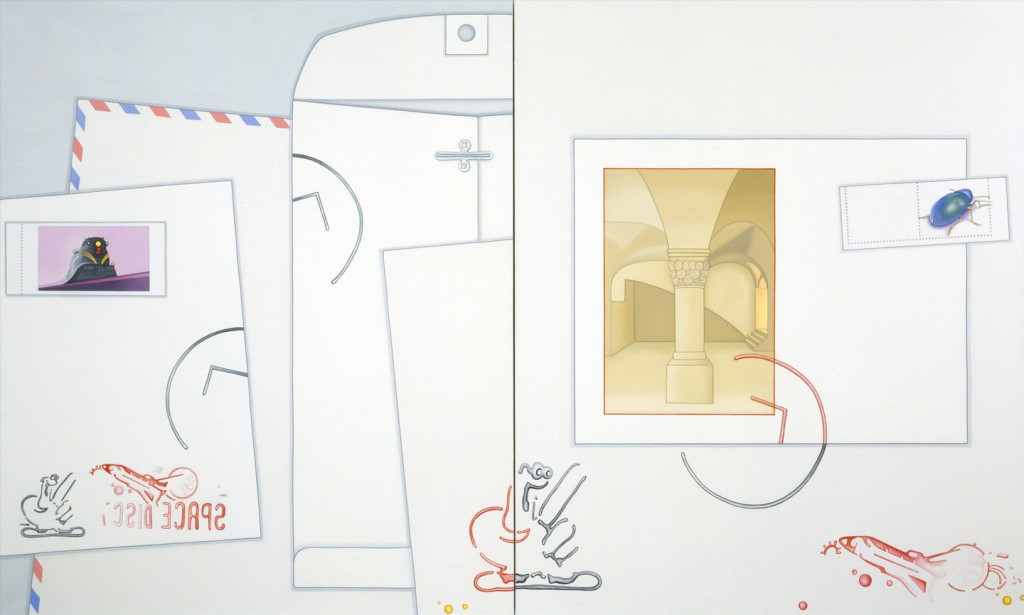Printed matter has long served as the visual and thematic context of Li-lan’s elegantly cool paintings. A stationer’s supply of envelopes, postal stamps from all over, cancellations and airmail indicators suggest a world crisscrossed by cosmopolitan personal connections. Colorful stamps, the wild cards in her game, introduce imagery of many styles, palettes and evocative possibilities. In the last works these images may become unmoored from their logical sites: outsize stamps bearing only an eye or a mouth, for example (sly introductions of self-portraiture). Schematically drawn airplanes, alligators, dancers and jewellike scarabs are freely deployed across the picture plane. Postal cancellations, like collectors’ chops on traditional Chiense paintings, may appear independent of their own stamps.
Included via postcards are illusionistic depictions of Italian Romanesque and Renaissance interiors, as well as fragments of isometrically rendered East Asian architecture. By situating such perspectival spaces upon the picture plane, Li-lan manages to have it both ways: preserving an exemplary modernist esthetic of flatness while enjoying a range of spatial structures and the lively play of variously rendered railroad trains, exotic creatures, and an affectionately considered diversity of typographical fonts.

Space Disco (diptych), 2002
Space Disco, comprising two 60-by-50 inch canvases, includes an unidentified stamps showing an approaching train seen from below against a warm violet sky, new envelopes and a blank sheet of paper. On the right panel a postcard shows a Romanesque crypt with soft, gradated light modeling its austere vaulted structure. An illusionistically rendered green-blue-purple beetle appears on a stamp. There are repeated renderings of hand-stamped, not quite legible cartoonish images and, backwards, the letters of the works’ title. But these paintings are much more than the inventory of their parts. The whites are in fact a subtle range of colors – warm, cool, creamy off-whites imbued with natural light. The slight impasto of the raised sculptural swirls on the Romanesque capitals or on the cancellation marks, once seen, draw you closer in to explore what proves to be a varied yet sensuously restrained surface. You notice the thin vermillion perimeter of the crypt image, the slight shadow at the edges of each piece of paper, the delicacy of the perforations, the gently authoritative physicality of each of the forms. Attentive looking reveals evidence of the hand and finely calibrated visual distinctions everywhere. As with Agnes Martin, what at first may appear mechanical is the work of a contemplative process that prizes modesty and equipoise as conditions of beauty.
Li-lan’s paintings are inevitably betrayed by reproduction, because her subject matter of impersonally printed surfaces would seem to be duplicated so precisely. What gets lost are scale, nuance, the variably hand-crafted surface and the subtle radiance that emanates from each canvas.